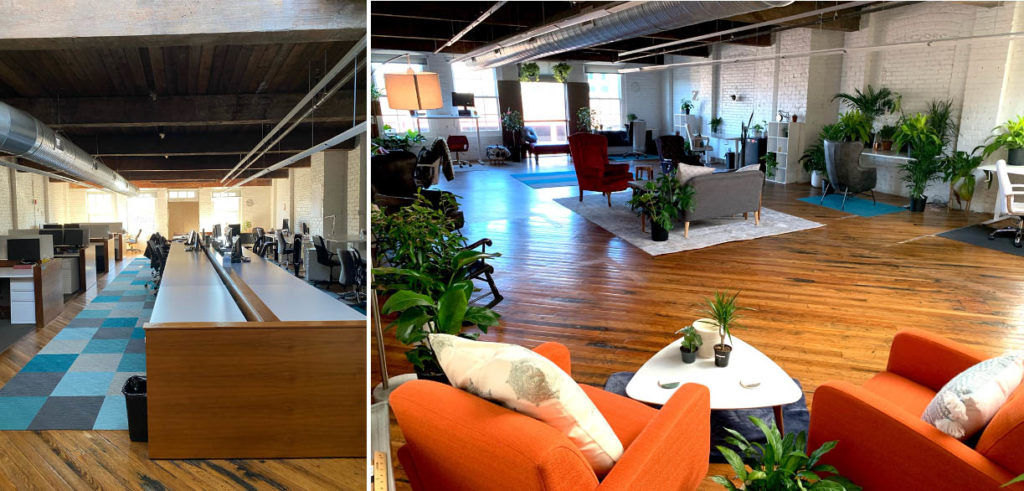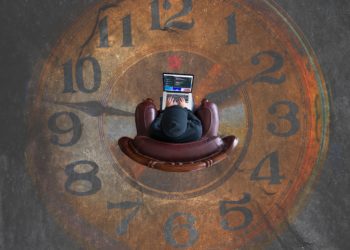Editor’s note: Today’s post is by Lily Garcia Walton. Lily is Chief People Officer at Silverchair in Charlottesville, VA.
At Silverchair, we have been pursuing our transformation to a hybrid work model through an inclusive design process, drawing heavily from end-user (i.e., employee) feedback. Pre-pandemic, all but a handful of our ~120 employees worked together full-time at Silverchair headquarters — an historic downtown Charlottesville office building known as the Hardware Store (after its original retail purpose many years ago). We had some reason to believe that our collocation at the Hardware Store was one of the secret ingredients that produced the vibrant, cohesive culture we all enjoyed.
Like so many organizations, the advent of the pandemic meant that we became fully remote nearly overnight. We instructed our people to take home their personal belongings and whatever office equipment they needed. We remained open for business during the pandemic in the sense that we allowed people to work at the Hardware Store if they followed strict safety protocols. Over time, however, nearly everyone gave up on this and Silverchair was thus unceremoniously transformed into a remote-first organization.
In January 2021, with the exciting prospect of vaccination on the horizon, we started to plan for what re-engagement with headquarters might look like on an expanding scale. It became clear to us, through survey feedback we gathered in January, that the vast majority of our employees had derived significant personal and professional benefit from remote work and, although we very much wanted to return to the office, almost nobody saw a need to return full-time. Based upon the impressive productivity our teams had been able to maintain throughout the pandemic, our leaders agreed.
So, we set about the process of designing a workplace that is optimized for hybrid work, allowing for flexibility at the individual level while also striving to create a team-level experience that promotes collaboration, creativity, and communication. Our goal is to bring together the most appealing aspects of remote and collocated work into a hybrid work model that is stronger than the sum of its parts. Our experience so far has led us to believe we can accomplish this by listening attentively to our people, doing our homework (keeping up with best practices, research, and the experiences of others in this area), and being willing to iterate on aspects of our model along the way.
Here is what we’ve done.

Employee surveys & feedback sessions
We began our process of workplace transformation in January with a remote workplace survey capturing employee sentiment about the relative challenges and benefits of working remotely versus at our headquarters. The feedback we gathered in this initial touchpoint convinced Silverchair’s leadership that we needed to find a way to re-engage with our physical office while preserving the flexibility our people had come to rely upon. We created a detailed presentation containing straw proposals for reopening based on our best thinking. Then, we systematically met with groups of people managers and Scrum Masters (the project managers of our software development teams) to gain clarity regarding:
- how our workplace was being used pre-pandemic;
- what our workplace was missing to make it fully optimized for those uses;
- how we should be thinking about ensuring that all employees — regardless of work modality — have what they need to feel included and remain productive; and
- how we should execute the process of inviting teams to re-engage with our headquarters space.
We learned a lot about how our work gets done and the ways in which our office space was and was not supporting that work. For example, we heard consistently that we have insufficient conference room space for team collaboration and ad hoc meetings. We also heard that the office got pretty noisy pre-pandemic and that some people really wanted quiet places to retreat to for work requiring concentration. Those who had experienced hybrid work pre-pandemic (either because they had remote teammates or had worked remotely themselves) acknowledged the challenge of ensuring inclusive team meetings and other interactions in which everyone — regardless of modality — can fully engage, participate, and contribute.
Along the way, we updated our plans to reflect the feedback we were getting. Then we took what we had learned and used it to craft a more open-ended employee survey asking deeper questions about what our people need to be successful in a hybrid modality. We gained higher quality insights and shared these company-wide. We continued to update and refine our plans, with greater confidence that we were headed in the best direction for our company and its people.
Early in our exploration process, we realized that what we needed to do was convert from a relatively static model in which everyone has an assigned work space to a dynamic co-working space model in which people reserve the work space they need from time to time.
Space reconfiguration & safety
Much of the feedback we have received related to how we configure our headquarters so that it is optimized for hybrid work. Early in our exploration process, we realized that what we needed to do was convert from a relatively static model in which everyone has an assigned work space to a dynamic co-working space model in which people reserve the work space they need from time to time.
To be sure, there will be some exceptions to this rule. Our Architecture team needs a permanent dedicated work space to house their equipment and promote collaboration. As well, our PeopleOps team needs a private area for sensitive conversations. And some Silverchairians need to work in the office five days a week because they lack adequate work space at home. Yet, the vast majority of our employees will be sharing work stations when they return to the Hardware Store. To help manage this, we are updating our building access technology to an app-based system that allows employees to check in and select a workspace after answering health screening questions.
Understandably, lots of people have expressed concern about the cleanliness of the space and the prevention of illness. We will continue to ask Silverchairians to help preserve the cleanliness of shared work areas and we will ensure that our cleaning crew remains conscientious and committed. We have also made the decision to require that anyone who works at headquarters be fully vaccinated, effective June 14th. More than half of our company has already confirmed their fully-vaccinated status in anticipation of a return to the office. Consistent with CDC guidance, we also recently announced that any fully vaccinated employee working in the office is not required to wear a mask. Those who do not feel comfortable going mask-free, of course, are welcome to make a different choice. Our goal is to foster an in-office work environment that feels safe, comfortable, and supportive for all.
As of the publication of this blog, Silverchair has begun renovations to turn our headquarters into an adaptable co-working space. A section of our office will now be designated as “The Library” (h/t Alison Mudditt!) — a space for those who want a quiet place to concentrate. Conversely, we are also designating an open area on one of our floors for those who like to work in the midst of conversation and ambient noise. We are renovating private office spaces to create additional conference rooms for team collaboration, and we have designed a “Silverchair Bistro,” a space with an expanded kitchen and large dining tables for our employees to share meals and socialize.
Hybrid Work Norms
Early in our journey, we recognized that the most critical part of transitioning to a hybrid work model would be establishing and propagating the right work norms. We had the good fortune of connecting with a graduate student whose concentration is effective remote and hybrid leadership and who was interested in studying Silverchair. With her help, we have been able to quickly amass a collection of organizational development research to inform our decisions about what hybrid work norms to consider. Part of this work has entailed mapping all our various communication channels and setting best practices.
We are refining and celebrating the Silverchair people brand and providing an air-tight onboarding experience to newcomers, who are the people most likely to become alienated in a hybrid work space. We are placing a premium on opportunities to socialize and build community.
Following the employee engagement process described above, we have also been gathering feedback from our people about how we need to adapt our ways of working to make the hybrid modality effective for Silverchair. Based on the research and the feedback, we have settled on seven areas of focus suggesting related work norms we believe will preserve and enhance both the productivity and happiness of our hybrid teams:
- Organize Intentional and Purposeful Gatherings. We are establishing guidelines for effectively planning and executing meetings of various types, selecting modality (online with/without video), location (collocated, remote, or hybrid), and agenda based on meeting purpose. We are providing company-wide training on how to run effective hybrid meetings. Much like our previous work around making video meetings less terrible, this framework helps us proceed with intentionality and flexibility that serves all participants.
- Balance Work-Life Flexibility with Accountability. We are establishing time zone specific “core work hours” when people agree to be available, then allowing scheduling flexibility on either side. We are also defining what “availability” means and setting clear and explicit expectations about employees setting work from hom (WFH)/in-office status and notifying key stakeholders of their plans.
- Ensure Inclusive Team Communications. Remote workers can be limited in their ability to be effective because they miss out on the valuable casual conversations that occur in a collocated space. So, we are setting team-level norms about when information needs to be conveyed to those who are not there to hear it and when a discussion needs to be paused so others are included. We are committing to including all necessary stakeholders in discussions and decision making – whether or not they are physically present. And, we are providing training to our leaders of people.
- Provide Outcomes-based, Growth-oriented, Ongoing Performance Management. In addition to semi-annual performance reviews, we are placing an emphasis on ongoing multi-directional feedback and 1:1 management checkpoints with a developmental focus. We are also conducting semi-annual skip-level “stay interviews” to identify and get ahead of performance and morale hot spots. Wherever possible, we are using data to track whether employee activities are off the mark while refocusing attention to individual, team-based, and company-wide measures.
- Actively Promote Community Building and Celebration. We are refining and celebrating the Silverchair people brand and providing an air-tight onboarding experience to newcomers, who are the people most likely to become alienated in a hybrid work space. We are placing a premium on opportunities to socialize and build community. In fact, we have already resumed weekly outdoor company happy hours and we are actively planning a company-wide learning day and a company picnic. Community matters above all and we are doubling down on nurturing those connections.
- Focus on Health and Wellbeing. We are taking a number of measures to promote the health and wellbeing of our employees and establish wellness as a cultural imperative. For instance, we are embracing healthy meeting norms, maintaining clear and explicit requirements regarding cleanliness at headquarters, encouraging appropriate home office setup (e.g., ergonomic guidelines), and exploring enhanced benefit options that support health and wellbeing (such as a company-wide subscription to a mindfulness app).
- Anticipate and Manage Logistics and Compliance. Silverchair’s leaders are also working both quickly and thoughtfully to answer logistical and compliance questions related to hybrid work, including:
- When should a job opening be posted as local versus geographically flexible?
- When is a worker “remote”? When is a trip to Silverchair a commute (employee responsibility) versus travel (Silverchair pays). This has implications for tax liability and state labor laws.
- Should there be any difference in technology provisioning for remote versus “local” workers? So far, our view is that we should provision all workers the same.
- When is it okay for a Charlottesville-based employee to move out of the area and work completely remote? We have established guidelines for managers to have these conversations, with our senior leaders as ultimate decision makers in consultation with me (our CPO).
Like organizations everywhere, Silverchair has been forever changed by the pandemic. We have abandoned traditional notions of what it means to be productive and team-oriented; and, we have created space for our employees to heavily influence our workplace of the future. Through the disciplined practice of engagement and curiosity, we have gained valuable insights about what it actually takes for us to evolve and thrive. I hope that hearing about our employee-centered thinking and planning inspires others, even as we continue to learn from your experiences in the post-pandemic world.
Discussion
10 Thoughts on "Guest Post — Designing for Hybrid Work: The Silverchair Story"
Thanks for sharing! It’s wonderful to see how workplaces are changing and adapting.
You’re welcome, Melanie!
Very interesting, thank you for sharing. How will you manage outside guest visits?
Great question, Melissa. Outside visitors who are not vaccinated will be required to wear a mask. Public access to the building is limited and all visitors must proceed to our reception desk.
What an excellent piece. Thank you Lily for sharing. Very insightful.
Thank you, Jasper.
Thanks, Jasper. I’m so glad it was helpful.
So insightful!
Thanks! I am glad to hear it was helpful.
Thanks!



